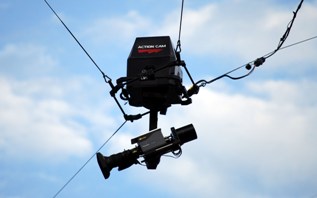Actioncam's HD Game Plan
Aerial camera systems have been a key component of sports
production since the 1980s, when Garrett Brown invented the Skycam system that
allowed directors to cover games with a mobile camera that hovered over the
field from a cable.
When P.J. Bennett founded Actioncam in 2007, though, the
startup's CEO believed he could create a significantly better system.

"I used to be a chief engineer with Skycam, which really
pioneered the aerial camera system in this business and blazed a great trail
for everyone," said Bennett. "But after talking to a number of directors and
producers about all the things they would like to have that they couldn't do or
at least do well, I decided to leave Skycam and start Actioncam."
Bringing the new system to market took time. While Bennett formed
the company in early 2007, he didn't line up funding until the middle of that
year. It took another 18 months or so the perfect the system.
But the result seems to be quickly gaining notice. In 2009, Actioncam
was used in the production of the NCAA Men's Basketball Final Four, the National
Basketball Association's Eastern Conference Finals and a number of college
football games, including the Southeastern Conference championship game in
December.
"The Final Four back in April marked the first time that a
three-dimensional camera was flown over the court in basketball for broadcast
TV," Bennett said.
Like other aerial systems, the camera head, which is fitted
with a Panasonic AK-HC1500 compact camera and a Fujinon HD13X4.5 Wide Angle lens,
moves around the stadium or venue on cables. Bennett's system uses larger, more
powerful reels and stronger transport lines, though, which allows the camera to
move at faster speeds.
Multichannel Newsletter
The smarter way to stay on top of the multichannel video marketplace. Sign up below.
Currently, the camera can accelerate up to 40 to 50 miles an
hour to quickly follow a player down the field, producing shots that are
designed to make the viewer feel like they're right on top of things.
"Our system is the fastest one out there and that allows you
to follow the action and get right in it," Bennett said. "You can't avoid
zooming in on the action and but the real trick to making the viewer fell like
he is in the action is to move the camera to the action.
"Every camera in the broadcast can zoom in on the action.
That is nothing special," he added. "The special part is having a shot that is
moving with the action."
Bennett said that a major reason for choosing the Panasonic
camera and Fujinon lens was his familiarity with the products, the quality of
their images and their reliability. The Panasonic camera also allows the system
to switch from 720p to 1080i depending on the broadcasters needs.
Bennett also praised the quality of the Fujinon and its
ability to provide the camera operator with
the flexibility to capture either a wide view of the field or to hone in on the
action, with a 13X zoom. "It gives you the best of both worlds," he said.
The Fujinon lens also is also easier to control and
integrate into the camera head that Bennett developed. Fujinon's digital servo
control system, Digi Power, "allows you to easily control the zoom and focus,"
he said. "It meant we could bring that right into our camera head electronics
and have direct control over it, which was a big plus."
Looking ahead, Bennett said Actioncam is taking a close look
at 3D production and hopes to use its success with the major sports leagues to
market the product to second-tier properties.
"There are a number of sports that don't have the big
budgets of a major sport, but want to get to the same level of quality," he
said. "We think we can help them with that because our system is less-expensive."
When P.J. Bennett founded Actioncam in 2007, the startup's CEO believed he could create a significantly better aerial camera system for sporting events.
